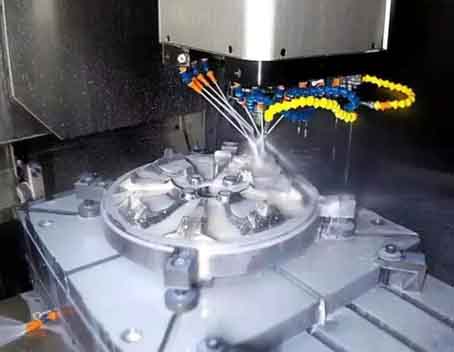100년 전, 고속 강철 절단 도구가 사용되기 시작했습니다., 일반강의 절삭속도는 25~30m/min에 불과했습니다.. 탄소공구강, 합금공구강과 비교, 해당 절단 속도에서의 처리는 다음과 같습니다. “고속 밀링”. 그러므로, “고속도강” 이름이 붙여졌다. 고속 스틸 도구가 방금 나타 났을 때 시대에, 미국 테일러 F.W. 엔지니어는 많은 CNC 절단 이론과 연습 작업을 수행했습니다., T-V 방정식을 확립했습니다. 그는 CNC 절단 기술 및 산업 관리에 큰 기여를했습니다..
50 여러 해 전에, 제 2 차 세계 대전이 끝난 직후, 시멘트 카바이드 도구가 널리 사용되기 시작했습니다. 그때에, 탄화물 도구를 사용하여 일반 강철을 자릅니다, 80-100m/분의 절단 속도를 사용할 수있었습니다. 그때에, 이 절단 속도가 호출되었습니다 “고속 밀링”.

고속 밀링 부품
4 월 1931, 독일 물리학 자 칼. J.. Saloman은 먼저 고속 밀링 이론을 제안하고 같은 해에 특허를 신청했습니다.. 그는 지적했다: 기존 절단 속도의 범위, 절단 속도의 증가에 따라 절단 온도가 증가합니다.. 하지만, 절단 속도가 특정 값으로 증가한 후, 절단 온도는 증가하지 않지만 감소합니다, 절단 속도 VC는 공작물 유형과 관련이 있습니다.. 각 공작물에 대해, 속도 범위가 있습니다, 이 속도 범위 내에서, 절단 온도가 높기 때문입니다, 도구 자료는 그것을 참을 수 없습니다, 그리고 절단 과정은 불가능합니다. 이 속도 범위를 초과 할 수있는 경우, 고속 밀링이 가능할 것입니다, 따라서 생산 효율성을 크게 향상시킵니다. 실험 조건의 제한으로 인해, 그 당시 고속 절단을 실천할 수 없었습니다., 그러나이 아이디어는 후손에게 매우 중요한 깨달음을 주었다.
고속 CNC 가공 기술은 4 단계를 거쳤습니다: 이론적 탐사, 응용 프로그램 탐색, 예비 응용 프로그램 및보다 성숙한 응용 프로그램, 그리고 현재 생산에서 대중화되었습니다. 특히 1980 년대 이후, 항공 산업과 곰팡이 산업의 요구는 고속 가공의 적용을 크게 촉진했습니다.. 항공기 부품에는 많은 수의 얇은 벽 부품이 있습니다., 날개 갈비와 같은, 긴 스트링거, 프레임 등. 그들은 벽과 갈비뼈가 매우 얇습니다, 가공 중에 금속 제거 속도는 매우 높습니다, 그리고 그들은 CNC 절단 변형이 발생하기 쉽습니다, CNC 처리에는 더 어려운 것입니다; 게다가, 항공기 제조업체는 또한 부품의 가공 효율성을 향상시키기 위해 긴급히 요구합니다., 따라서 항공기의 배달 시간이 단축됩니다. 곰팡이 산업과 자동차 산업에서, 곰팡이 제조가 핵심입니다. 곰팡이 전달주기를 단축하고 곰팡이 제조의 품질 향상은 또한 사람들의 노력의 장기 목표입니다.. 고속 절단은 의심 할 여지없이 이러한 문제를 해결하는 중요한 방법입니다.. 1990 년대부터, 고속 가공은 제조 산업에서 점차 홍보 및 적용되었습니다.. 현재, 통계에 따르면, 미국과 일본에서, ~에 대한 30% 회사는 고속 가공을 사용했습니다, 그리고 독일에서, 이 비율은보다 높습니다 40%. 항공기 산업에서, 고속 밀링은 일반적으로 가공 부품에 사용되었습니다.
현재, 고속 절단은 어느 정도 적용되었습니다, 그러나 고속 밀링에 정확한 정의를 제공하는 것은 여전히 어렵습니다., 그리고 고속 절단의 밀링 속도 범위를 제공하기가 어렵습니다.. 고속 절단은 상대적인 개념입니다, 처리 자료와 큰 관계가 있습니다, 처리 방법, 도구, 절단 매개 변수 등. 일반적으로 고속 절단의 밀링 속도는 5-10 기존의 절단 속도의 시간. 일반적으로 사용되는 재료의 경우, 일부 재료는 거친 데이터를 제공합니다: 알루미늄 합금 1500 ~ 5500 m/min;
구리 합금 900 5000m/분;
티타늄 합금 100 all 1000 m/min;
주철 750 ~ 4500 m/min;
강철 600 00 800 m/min. 다양한 재료의 고속 절단을위한 공급 속도 범위는 2 ~ 25m/min입니다..
 English
English العربية
العربية 中文(漢字)
中文(漢字) Čeština
Čeština Dansk
Dansk Nederlands
Nederlands Suomi
Suomi Français
Français Deutsch
Deutsch Italiano
Italiano 日本語
日本語 ಕನ್ನಡ
ಕನ್ನಡ 한국어
한국어 Português
Português Русский
Русский Slovenčina
Slovenčina Español
Español Svenska
Svenska Türkçe
Türkçe

